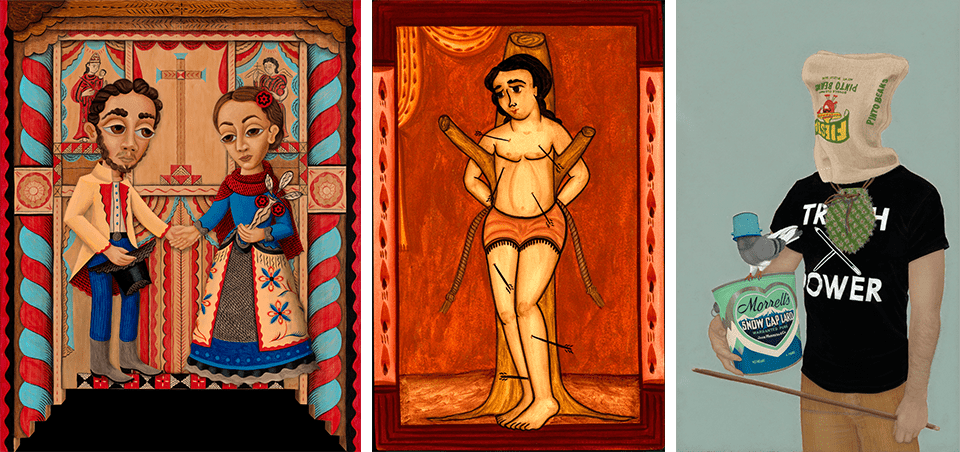Vicente Telles and Brandon Maldonado: Cuentos Nuevomexicanos
New Mexican artists Vicente Telles and Brandon Maldonado passionately engage and adapt a living tradition to tell stories for our times.
Extended through June 25, 2023
Engaging a Living Tradition
Artists Vicente Telles and Brandon Maldonado are forging new links in the chain of the continuing story of the people of New Mexico. Telles is firmly rooted in the santero tradition (the making of santos, or images of saints), while Maldonado describes his work as being heavily inspired by New Mexican folk art. Yet they see their work converging on the critical question: What can and should Santero art be now? This question is explored in a new MOCRA exhibition that introduces the work of Telles and Maldonado to St. Louis audiences.
The practice of making and venerating santos originated in Spain and was carried to territories under Spanish colonial rule. New Mexican santeros (makers of santos) developed distinctive approaches that diverged from the models they found in imported oil paintings, statues and devotional prints. The Santero tradition flourished from the mid-18th to late-19th centuries before falling into a period of decline. It recovered, however, and thrives today, responding to the needs of both religious devotees and art aficionados.
Santos continue to be essential to the devotional practices of families and communities, but they are also appreciated as art objects. Telles and Maldonado recognize the classic santeros as artists with agency who made adaptive choices in response to complex social concerns and matters of faith for their communities. Telles and Maldonado similarly approach the interwoven threads of contemporary New Mexican culture as informed, thoughtful practitioners. What aesthetic value does Santero art offer to the wider art world today? How can it be released from the confines of a religious folk form and redeemed from commodification? Not content with reiterating the past, Telles and Maldonado passionately engage a living tradition to tell stories for our times.
Listen to an interview with the artists:
About the Artists
Vicente Telles
Vicente Telles (b. 1983) is a santero and cultural iconographer driven by the desire to honor the culture and traditions of his native New Mexico. Telles began painting traditional retablos using handmade pigments and gesso, but his style has evolved to include experimentation with different mediums such as textiles, hand-pulled papers and found and repurposed materials. His more contemporary pieces, including his social commentary retablos and ongoing border culture series, feature reinterpretations of traditional Catholic and cultural iconography. To Telles, whose work can be found in private and public collections both in the U.S. and abroad, his artistry is about far more than painting; it means “being a teacher, a student and an observer of tradition and maker of the contemporary.” His santos and contemporary pieces transcend religion, allowing Telles to do his part to keep his heritage and centuries of tradition alive and vibrant.
Brandon Maldonado
Brandon Maldonado (b. 1980) was raised in Albuquerque, New Mexico, where he grew up on the graffiti art of his barrio surroundings. He rejected the academically painted Southwestern landscapes that seemed a far cry from the graffiti-filled streets of his personal reality. However, the culturally rich environment of New Mexico made a lasting impact on his work, which often explores themes associated with Mexican culture. The history and culture of the land fascinate him, as well as its living and historical ties to the story of Mexico and its mestizo legacy. Though primarily a self-taught artist, Maldonado holds a Bachelor of Arts in Humanities with an emphasis on philosophy and religion from the College of Santa Fe, and fittingly, he sees his art as a means to expressing ideas. Maldonado is perhaps best known for his Dia de los Muertos-themed images, which he has explored and evolved for more than two decades. His image Our Lady of Merciful Fate was featured on the cover of the Zac Brown Band’s 2012 Grammy-winning album Uncaged.
